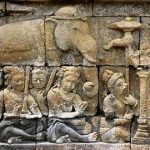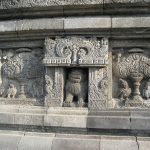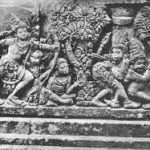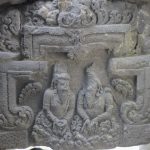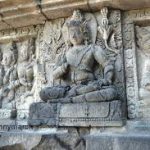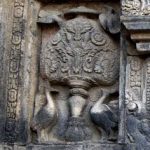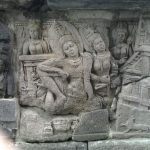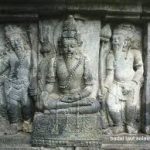Prambanan
Siwagrha (the house o Shiva), or Siwalaya (the realm of Shiva)
This temple is a UNESCO World Heritage Site, the largest Hindu temple in Indonesia, as well as one of the most beautiful temples in Southeast Asia. The architecture of this building is tall and slender in accordance with Hindu architecture in general with the Shiva temple as the main temple having a height of up to 47 meters towering in the middle of a complex of smaller temples. As one of the grandest temples in Southeast Asia, Prambanan temple attracts tourists from all over the world.
According to the Siwagrha inscription, this temple was built around 850 AD by Rakai Pikatan, and continued to be developed and expanded by Balitung Maha Sambu, during the Medang Mataram kingdom.
Etymology
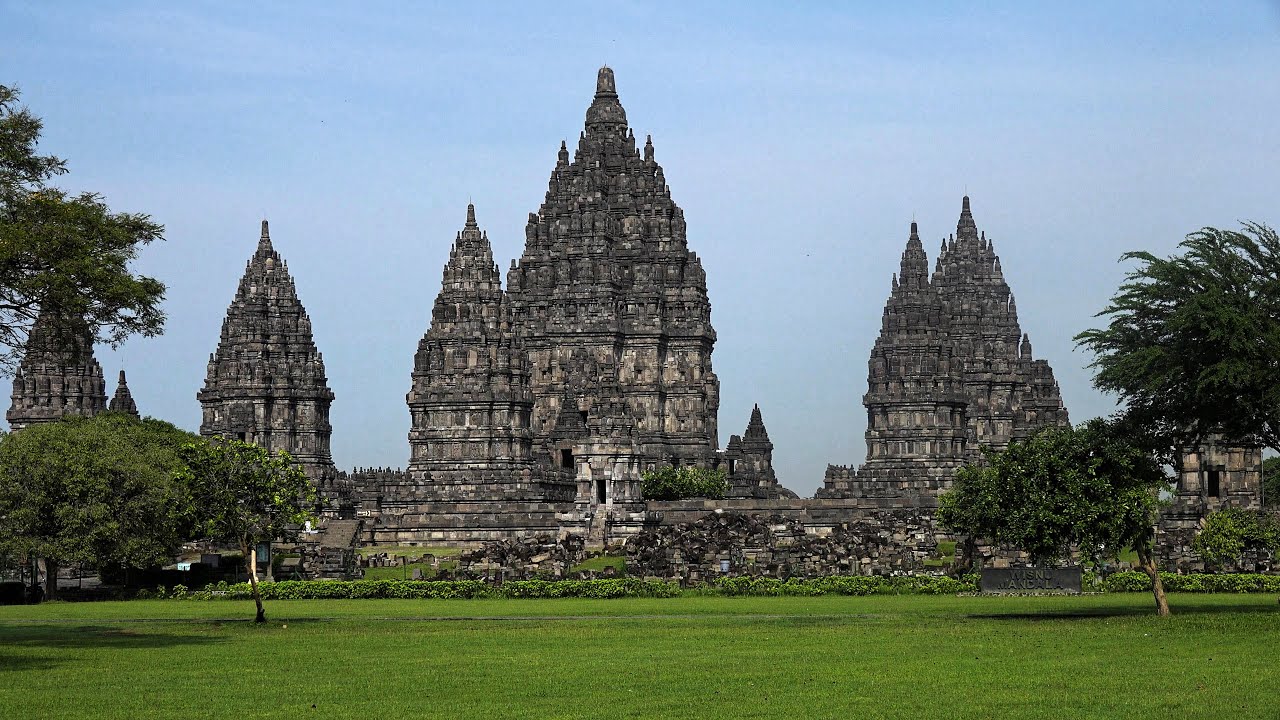 The name Prambanan, derived from the name of the village where the temple stands, is thought to be a change in the name of the Javanese dialect from the Hindu theological term Para Brahman which means “Great Brahman”, namely Brahman or the highest and greatest immortal reality that cannot be described, which is often equated with the concept of God in Hinduism.
The name Prambanan, derived from the name of the village where the temple stands, is thought to be a change in the name of the Javanese dialect from the Hindu theological term Para Brahman which means “Great Brahman”, namely Brahman or the highest and greatest immortal reality that cannot be described, which is often equated with the concept of God in Hinduism.
Another opinion thinks the Brahman might refer to the heyday of this temple which was once filled with brahmins. Another opinion proposes that the name “Prambanan” comes from the root word mban in Javanese which means to bear or assume duties, referring to the Hindu deities who carry out the task of organizing and carrying out the harmony of the universe.
 Another name for Prambanan can mean 5 (five) mountains which in the Khmer / Cambodian language 5 (five) are Pram and banam are mountains (ប្រាំ ភ្នំ). This depicts the 5 mountain peaks of the Himalayas in India. Remembering at the same time in the Khmer chronicles that the Javanese had colonized the Khmer for 200 years and the second Jayawarman who was in Java was a hero who freed the Khmer from Javanese domination.
Another name for Prambanan can mean 5 (five) mountains which in the Khmer / Cambodian language 5 (five) are Pram and banam are mountains (ប្រាំ ភ្នំ). This depicts the 5 mountain peaks of the Himalayas in India. Remembering at the same time in the Khmer chronicles that the Javanese had colonized the Khmer for 200 years and the second Jayawarman who was in Java was a hero who freed the Khmer from Javanese domination.
The original name of this Hindu temple complex is the name from Sanskrit; Siwagrha (House of Shiva) or Siwalaya (Alam Siwa), based on the Siwagrha Inscription dated 778 Saka (856 AD). Trimurti is honored in this temple complex with three main temples honoring Brahma, Shiva, and Wisnu. However, Shiva Mahadeva who occupies the main room of the Shiva temple is the most glorified deity in this temple complex.
Temple Complex
The architectural model of the reconstruction of the Prambanan temple complex, originally there were 240 temples standing in this complex.
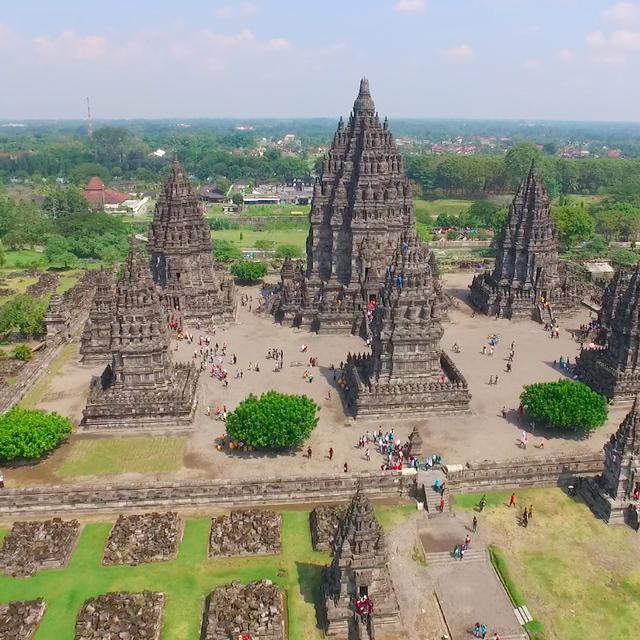 3 Trimurti Temples: Shiva, Wisnu, and Brahma temples
3 Trimurti Temples: Shiva, Wisnu, and Brahma temples
3 Wahana Temples : Nandi, Garuda, and Swan temples
2 Candi Apit: located between the rows of Trimurti temples and Wahana temples on the north and south sides
4 Candi Kelir: located in the 4 cardinal directions just behind the entrance to the inner courtyard or core zone
4 Candi Patok: located on the 4 corners of the inner courtyard or core zone
224 Perwara Temples: arranged in 4 concentric rows with the number of temples from the innermost to the outer rows: 44, 52, 60, and 68
Then there are a total of 240 temples in the Prambanan complex.
Originally there were 240 large and small temples in the Prambanan Temple complex. But now only 18 temples remain; namely 8 main temples and 8 small temples in the core zone and 2 ancillary temples. There are many ancillary temples that have not been restored, of the 224 ancillary temples only 2 have been restored, the only remaining is a scattered pile of stones. The Prambanan temple complex consists of three zones; the first is the outer zone, the second is the middle zone which consists of hundreds of temples, the third is the inner zone which is the holiest zone where the eight main temples and eight small shrines.
 The cross section of the plan of the Prambanan temple complex is based on a square land consisting of three parts or zones, each of which is bordered by andesite stone walls. The outer zone is marked by a square fence with a length of 390 meters on each side, with a Northeast – Southwest orientation. Except for the southern gate that is still left, many other parts of the gate and the walls of this temple have been missing. The exact function of this outer page is unknown; it is likely sacred garden grounds, or the dormitory complex of the Brahman and his disciples. Maybe in the past the building that stood in the outer courtyard was made of wood, so that it was rotten and nothing was left.
The cross section of the plan of the Prambanan temple complex is based on a square land consisting of three parts or zones, each of which is bordered by andesite stone walls. The outer zone is marked by a square fence with a length of 390 meters on each side, with a Northeast – Southwest orientation. Except for the southern gate that is still left, many other parts of the gate and the walls of this temple have been missing. The exact function of this outer page is unknown; it is likely sacred garden grounds, or the dormitory complex of the Brahman and his disciples. Maybe in the past the building that stood in the outer courtyard was made of wood, so that it was rotten and nothing was left.
Prambanan Temple is one of the largest Hindu temples in Southeast Asia besides Angkor Wat. The three main temples are called Trimurti and are dedicated to the three main gods of Trimurti: Shiva the Destroyer, Vishnu the Preserver and Brahma the Creator. In this temple complex, Shiva took precedence and more honor than the other two Trimurti gods. Shiva Temple as the main building as well as the largest and highest, towering as high as 47 meters.
Architecture
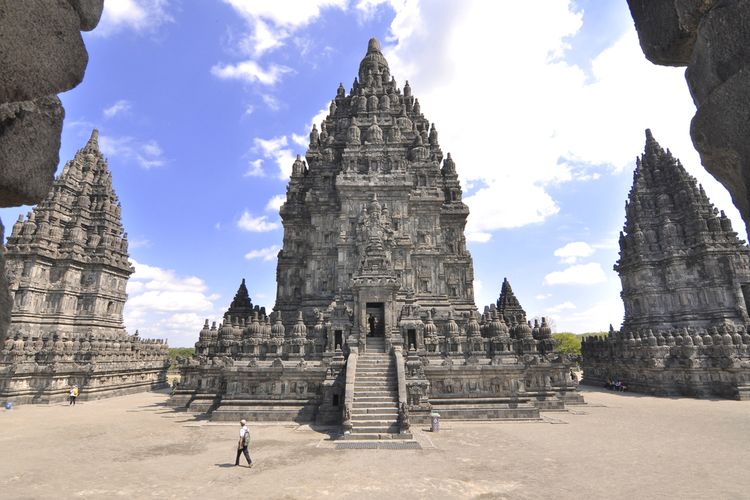 Prambanan temple architecture is guided by the Hindu architectural tradition which is based on the Wastu Sastra book / Silpastra book. The temple plan follows a mandala pattern, while the temple’s towering shape is characteristic of Hindu temples. Prambanan has the original name Siwagrha and is designed to resemble Shiva’s house, which is following the form of the holy mountain Mahameru, where the gods reside. All parts of the temple complex follow the universe model according to the Hindu cosmological concept, which is divided into several layers of the realm, nature or Loka.
Prambanan temple architecture is guided by the Hindu architectural tradition which is based on the Wastu Sastra book / Silpastra book. The temple plan follows a mandala pattern, while the temple’s towering shape is characteristic of Hindu temples. Prambanan has the original name Siwagrha and is designed to resemble Shiva’s house, which is following the form of the holy mountain Mahameru, where the gods reside. All parts of the temple complex follow the universe model according to the Hindu cosmological concept, which is divided into several layers of the realm, nature or Loka.
Like Borobudur, Prambanan also has levels of temple zones, ranging from the less holy to the most sacred. Despite their different names, each of these Hindu concepts has a counterpart in the Buddhist concept which is essentially the same. Both the floor plan horizontally and vertically are divided into three zones:
Bhurloka (in Buddhism: Kamadhatu), is the lowest realm of mortals; humans, animals, ghosts and demons as well. In this realm humans are still bound by lust, desire, and unholy way of life. The outer courtyard and the foot of the temple symbolize the realm of Bhurloka.
Bwahloka (in Buddhism: Rupadhatu), is the realm of the tegah, the place of saints, sages, ascetics, and lowly gods. In this realm man begins to see the light of truth. The central courtyard and body of the temple represent the realm of bwahloka.
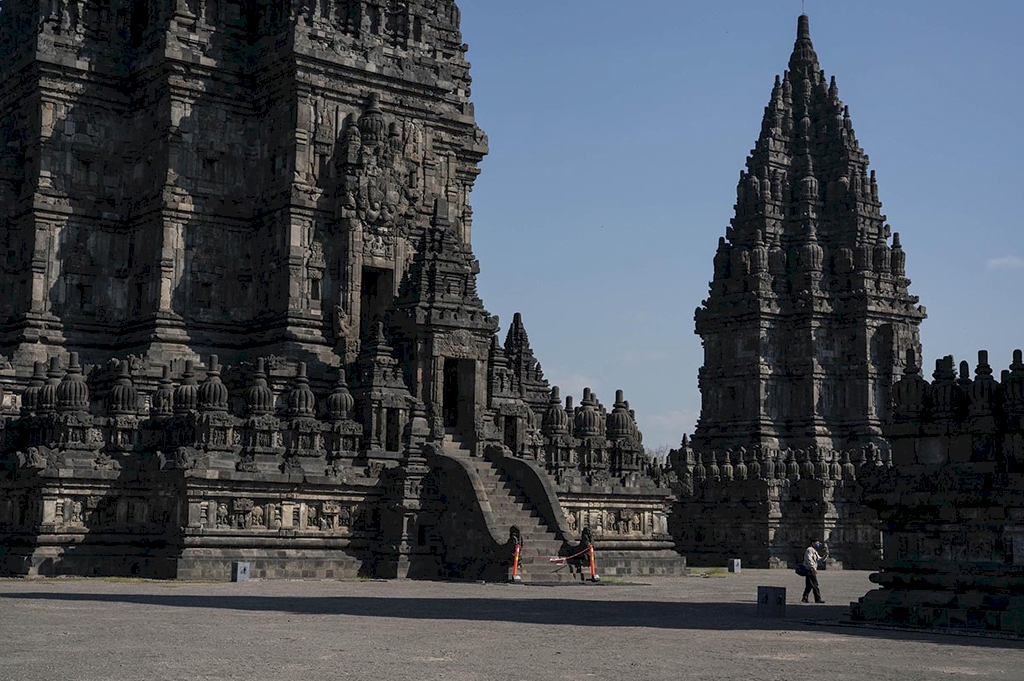 Swahloka (in Buddhism: Arupadhatu), is the highest and holiest realm where the gods Hapsara Hapsari Bidadari resides, also called swargaloka. The inner courtyard and roof of the temple represent the realm of swahloka. The roofs of the temples in the Prambanan complex are decorated with mastaka tops in the form of pearls (Sanskrit: jewels), the Prambanan ratna form is a modification of the wajra form which symbolizes diamond or lightning. In ancient Javanese Hindu architecture, the ratna is the Hindu counterpart to the Buddhist stupa, which serves as the temple’s top or mastaka.
Swahloka (in Buddhism: Arupadhatu), is the highest and holiest realm where the gods Hapsara Hapsari Bidadari resides, also called swargaloka. The inner courtyard and roof of the temple represent the realm of swahloka. The roofs of the temples in the Prambanan complex are decorated with mastaka tops in the form of pearls (Sanskrit: jewels), the Prambanan ratna form is a modification of the wajra form which symbolizes diamond or lightning. In ancient Javanese Hindu architecture, the ratna is the Hindu counterpart to the Buddhist stupa, which serves as the temple’s top or mastaka.
At the time of restoration, just below the Shiva statue under the main room of the Shiva temple there is a well on which there is a pripih (stone box). This well is 5.75 meters deep and the pripih stone coffin was found on a pile of charcoal, soil, and the bones of animal victims. Inside this pripih there are sacred objects such as gold sheets with characters that read Baruna (sea god) and Parwata (mountain god). In this stone coffin, there are copper sheets mixed with charcoal, ash, and earth, 20 ancient coins, several gems, glass, pieces of gold, and silver sheets, shells, and 12 gold sheets (5 of which are shaped like turtles, dragon snakes (cobra), lotus, altar, and egg).

